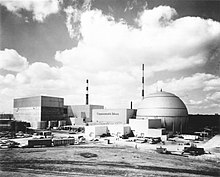Dresden Nuclear Power Plant
| Dresden Generating Station | |
|---|---|

Exterior view of Dresden Station circa 1971
|
|
| Country | United States |
| Location | Goose Lake Township, Grundy County, near Morris, Illinois |
| Coordinates | 41°23′23″N 88°16′5″W / 41.38972°N 88.26806°WCoordinates: 41°23′23″N 88°16′5″W / 41.38972°N 88.26806°W |
| Status | Operational |
| Commission date | Unit 1: 1960 Unit 2 (950 MW): June 9, 1970 Unit 3 (935 MW): November 16, 1971 |
| Decommission date | Unit 1 (207 MW): 1978 |
| Operator(s) | Exelon Corporation |
| Nuclear power station | |
| Reactor type | Boiling water reactor |
| Reactor supplier | General Electric |
| Power generation | |
| Units operational | 2 |
| Units decommissioned | 1 |
| Nameplate capacity | 1885 MW |
| Average generation | 15053 GW·h |
|
Website Profile at exelon.com |
|
Dresden Generating Station (also known as Dresden Nuclear Power Plant or Dresden Nuclear Power Station) is the first privately financed nuclear power plant built in the United States. Dresden 1 was activated in 1960 and retired in 1978. Operating since 1970 are Dresden units 2 and 3, two General Electric BWR-3 boiling water reactors. Dresden Station is located on a 953-acre (386 ha) site in Grundy County, Illinois, at the head of the Illinois River, near Morris, Illinois. It is immediately northeast of the Morris Operation—the only de facto high-level radioactive waste storage site in the United States. It serves Chicago and the northern quarter of the state of Illinois, capable of producing 867 megawatts of electricity from each of its two reactors, enough to power over one million average American homes.
In 2004, the Nuclear Regulatory Commission (NRC) renewed the operating licenses for both reactors, extending them from forty years to sixty.
Between the 1970s and 1996, Dresden was fined $1.6 million for 25 incidents.
The Nuclear Regulatory Commission defines two emergency planning zones around nuclear power plants: a plume exposure pathway zone with a radius of 10 miles (16 km), concerned primarily with exposure to, and inhalation of, airborne radioactive contamination, and an ingestion pathway zone of about 50 miles (80 km), concerned primarily with ingestion of food and liquid contaminated by radioactivity.
The 2010 U.S. population within 10 miles (16 km) of Dresden was 83,049, an increase of 47.6 percent in a decade, according to an analysis of U.S. Census data for msnbc.com. The 2010 U.S. population within 50 miles (80 km) was 7,305,482, an increase of 3.5 percent since 2000. Cities within 50 miles include Chicago (43 miles to city center).
Both units are owned and operated by Exelon.
The Nuclear Regulatory Commission's estimate of the risk each year of an earthquake intense enough to cause core damage to the reactor at Dresden was 1 in 52,632, according to an NRC study published in August 2010.
...
Wikipedia

